Passion fruit is a unique and exotic tropical fruit that offers a plethora of health benefits and tastes. Its sweet, tangy flavor makes it an excellent addition to various dishes and recipes, or it can be enjoyed on its own.
Learning how to eat passion fruit is a simple process that allows one to unlock the full potential of this delicious fruit and all it has to offer.
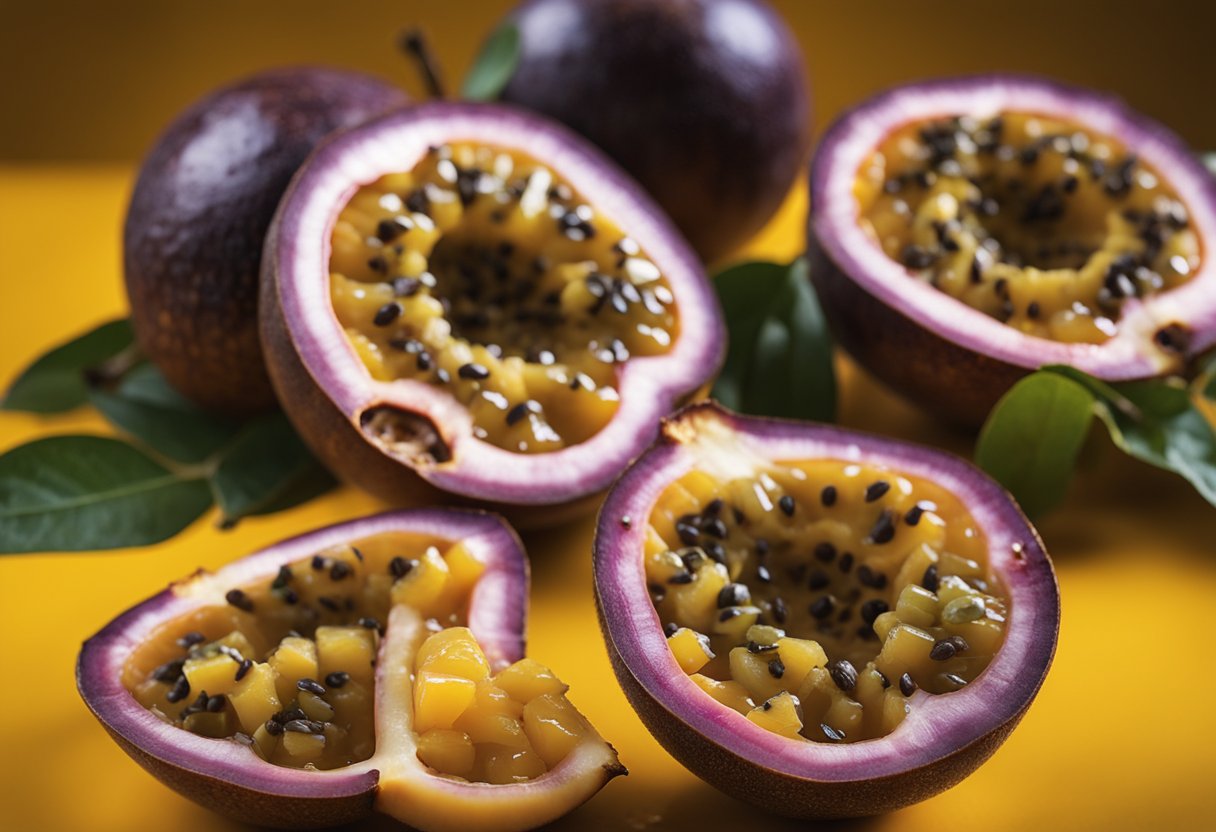
When selecting passion fruit, it is essential to choose fruits with a smooth, slightly wrinkled skin, as this indicates ripeness. Once the fruit has been thoroughly washed, it can be cut in half using a serrated knife, revealing the gelatinous pulp and seeds inside.
The seeds are edible but tart, and can be scooped out of the fruit with a spoon and directly eaten, or incorporated into recipes and dishes for added flavor. How to Eat Passion Fruit: Instructions and Recipes – Healthline
In addition to enjoying it fresh, passion fruit can be turned into juice by blending the pulp and seeds, then straining the mixture to separate the juice from the crushed seeds. This juice can be used to create beverages, sauces, or even desserts, adding a burst of tropical flavor to any dish.
Related: How to Know if Passion Fruit is Ripe: Expert Tips for Perfect Selection
What is passion fruit?
Passion fruit is a unique and flavorful tropical fruit that grows on the vines of the Passiflora plant, a type of passion flower. The fruit comes in various colors, such as purple, yellow, and red.
Its outer shell is hard, while the inside is filled with a juicy, gelatinous pulp containing edible black seeds. The skin can be either smooth or wrinkled, depending on the fruit’s ripeness.
The taste of passion fruit is a delightful combination of sweet and tart, with the juice being particularly refreshing and fragrant.

The fruit’s distinctive flavor has made it a popular choice for adding a tropical twist to various dishes and beverages. Not only is passion fruit delicious, but it also boasts a range of nutritional benefits, being rich in antioxidants, fiber, vitamins, and other plant compounds.
This mouthwatering fruit is typically enjoyed by cutting it in half and scooping out the pulp with a spoon. The pulp can be eaten as is or incorporated into a variety of recipes, including smoothies, salads, desserts, and sauces.
Whether you are a passionate fan of this tropical treat or new to the world of passion fruit, its vibrant taste and nutritional benefits make it a fantastic addition to a healthy diet.
Identifying a ripe passion fruit
When choosing a passion fruit, it is essential to identify one that is ripe to ensure a delightful eating experience. One of the key indicators of ripeness in a passion fruit is the state of its skin.
A ripe passion fruit will typically have wrinkled, dimpled skin, whereas an unripe one will have a smoother surface. It is also important to note that excessively wrinkled fruit may be past its peak and not as fresh.
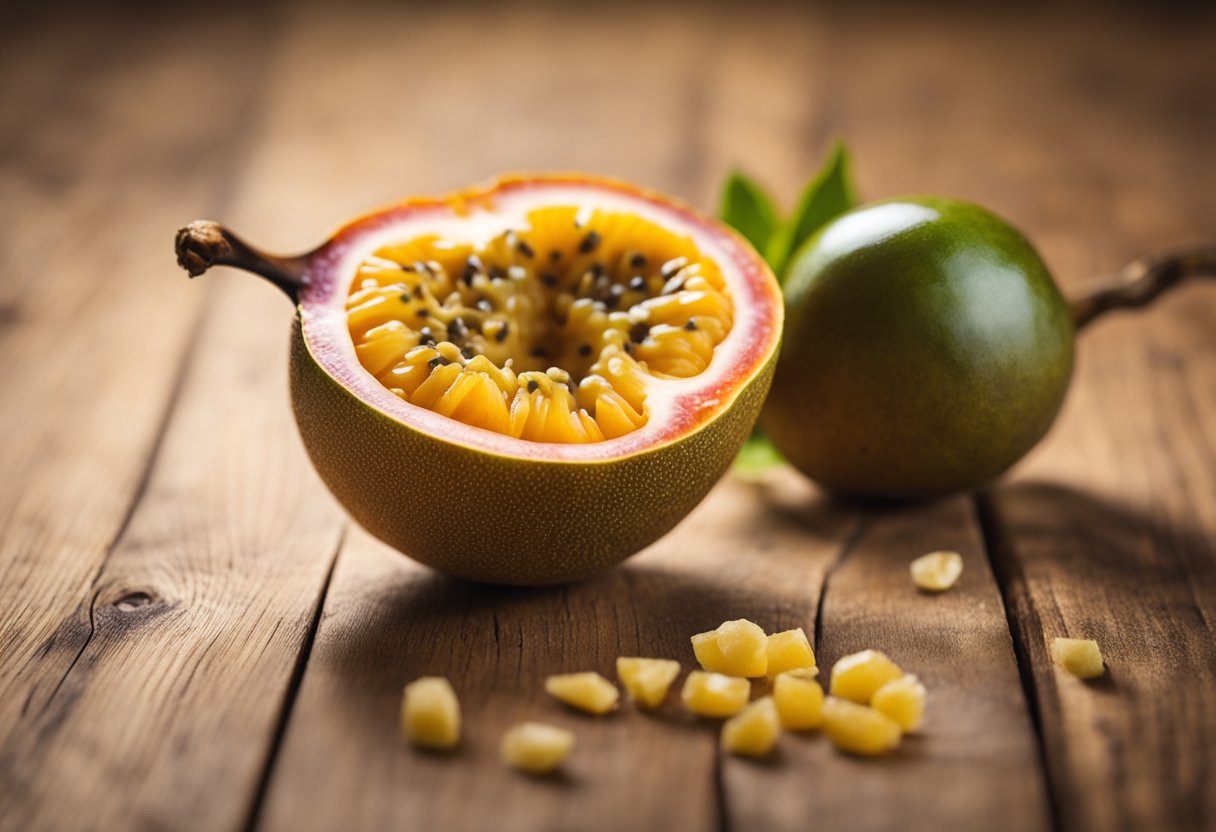
Another factor to consider when selecting a ripe passion fruit is its weight. A ripe and ready-to-eat passion fruit will feel heavier than an unripe one, giving an indication of its juiciness and flavor. By holding the fruit in your hand, you can easily gauge its weight and feel if there is a little give when gently squeezed – a sign of ripeness and juiciness.
Moreover, it is crucial to examine the passion fruit for any signs of damage. Avoid fruits with significant discolored spots or those that appear to be leaking, as these may be indicators of spoilage or poor quality. Instead, opt for passion fruits displaying vibrant colors and free of any apparent defects.
By taking these factors into account, you can confidently choose a ripe passion fruit that will deliver a delectable taste and an enjoyable eating experience.
How to properly cut a passion fruit
Cutting a passion fruit is a simple process that requires a sharp knife or a serrated knife. Start by washing the fruit thoroughly under running water to remove any pesticides, dirt, and bacteria. It is important to clean the fruit, as contaminants from the skin can be transferred to the interior pulp when slicing.
Next, place the passion fruit on a cutting board and use a sharp knife or a serrated knife to cut it in half. Slice the fruit longitudinally, from top to bottom, applying gentle pressure to ensure a clean and even cut. Cutting the fruit this way will help you extract the pulp efficiently and minimize any waste.

Once you have successfully sliced the passion fruit, you will see the juicy, seed-filled pulp inside. This pulp can be scooped out with a spoon and enjoyed on its own or added to various recipes, such as smoothies, yogurt, and desserts.
In summary, follow these simple steps for cutting passion fruit:
- Wash the fruit thoroughly to remove contaminants.
- Use a serrated knife or a sharp knife to make a clean cut.
- Cut the fruit longitudinally from top to bottom.
- Scoop out the pulp and seeds with a spoon for consumption.
Eating passion fruit: the basics
Passion fruit is a unique and flavorful tropical fruit rich in nutrients and antioxidants, making it an excellent addition to your diet. When first encountering a passion fruit, one may wonder how to properly consume it. Here we present a simple and easy guide to eating passion fruit.
Start by cutting the passion fruit in half using a serrated knife. This will expose the gelatinous pulp and edible seeds inside, which have a sweet and tart taste. The most common and basic method of eating passion fruit involves simply using a spoon to scoop out the pulp and seeds directly from the fruit’s rind. The experience of biting into the passion fruit’s seeds offers a satisfying crunch to balance out the soft pulp.
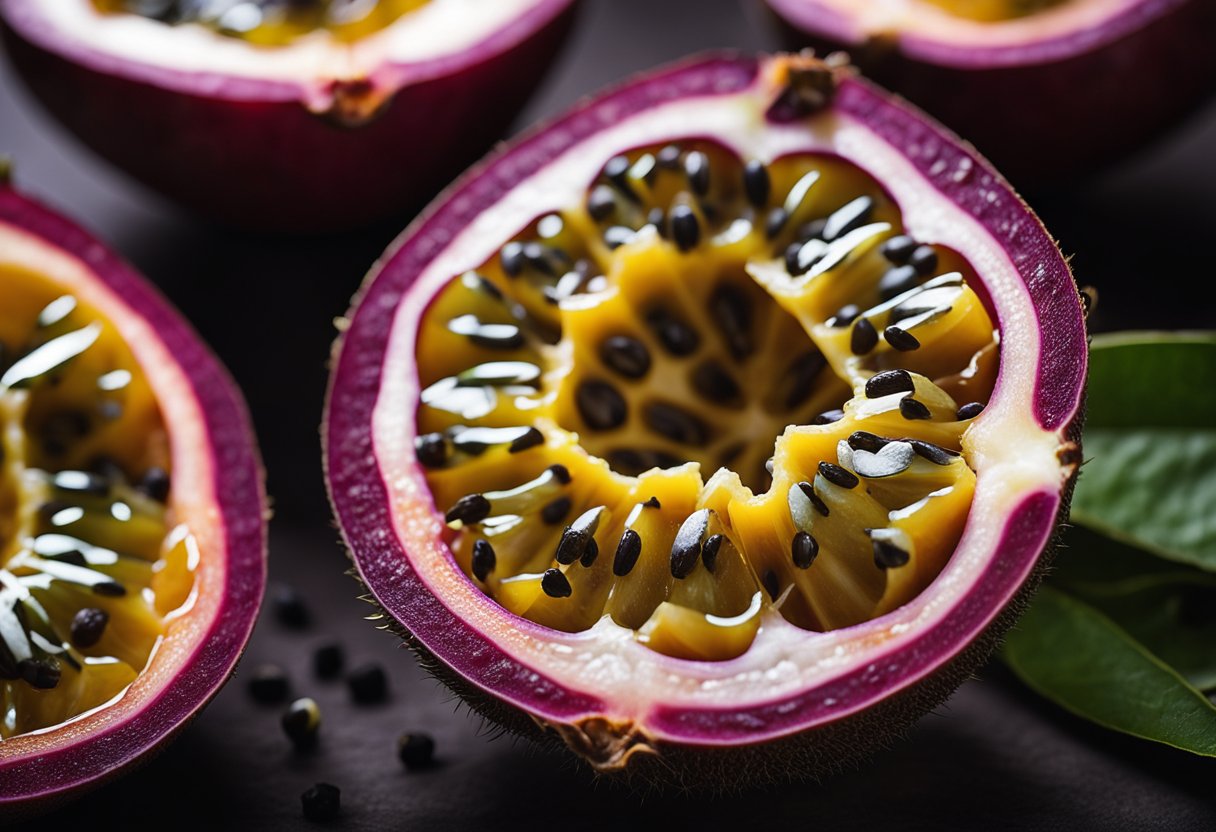
For those who prefer a milder tartness, it is perfectly acceptable to add a dash of sugar or drizzle of honey over the pulp and seeds, creating a balance between tart and sweet flavors. The passion fruit can also be mixed into fruit salads or topped onto yogurt, giving these dishes an added boost of flavor and texture.
While the rind of the passion fruit is not edible, don’t hesitate to use it as a serving bowl for your scoop of pulp and seeds. This not only adds a unique touch to your dish, but also makes for an environmentally friendly dishware choice.
In conclusion, eating passion fruit is both simple and enjoyable. Just remember to use a spoon to scoop out the seeds and pulp, and feel free to incorporate them into other dishes or enjoy them on their own. With these basics in mind, anyone can confidently indulge in the delicious world of passion fruit.
Incorporating passion fruit into drinks
Passion fruit is a versatile fruit that can easily be incorporated into a variety of drinks. Its tangy, tropical flavor pairs well with a wide range of ingredients, making it a popular choice for refreshing beverages.
One simple way to enjoy passion fruit in a drink is by making passion fruit juice. To do this, scoop the pulp and seeds from the fruit into a blender, pulse a few times to break the juice-containing membrane around each seed, and then strain the mixture to separate the crushed seeds from the juice (source). The resulting juice can be enjoyed on its own or mixed with other flavors in a fruit smoothie.
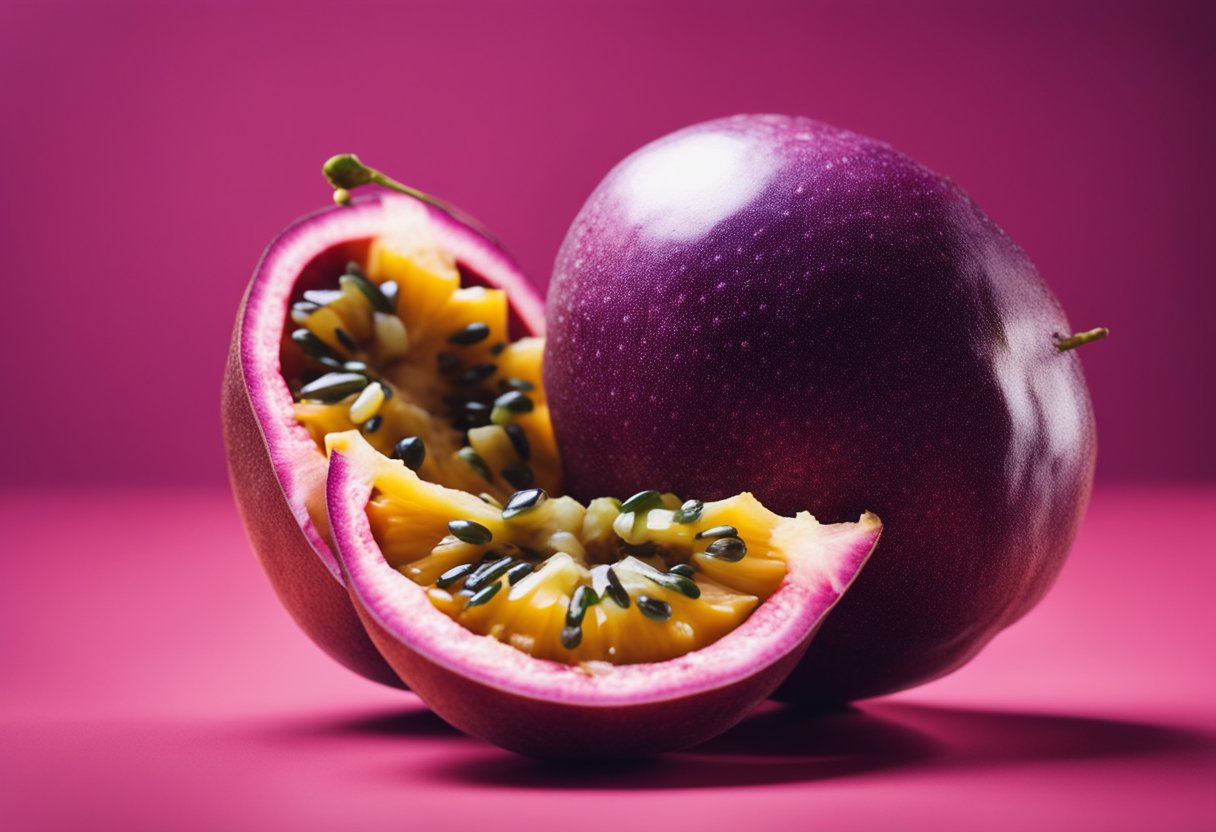
For those who enjoy cocktails, passion fruit can add an exotic twist to traditional recipes. For example, passion fruit margaritas are a fun and fruity spin on the classic margarita.
To make a passion fruit margarita, simply replace some of the lime juice with passion fruit juice and blend it together with tequila, orange liqueur, and ice. The combination of sweet and tangy flavors creates a delightful balance that is sure to impress guests at your next gathering.
In addition to cocktails, passion fruit can also be used as a base for non-alcoholic drinks. For example, a passion fruit lemonade can be made by combining passion fruit juice with freshly squeezed lemon juice, water, and sugar to taste. This refreshing, tart beverage is perfect for sipping on a hot summer day.
Finally, don’t forget to consider incorporating passion fruit into your morning routine by adding it to a fruit smoothie. Its unique flavor pairs well with a variety of fruits like mango, pineapple, and banana. Blend it with some yogurt, milk, or juice, and you have a delicious and healthy way to start your day.
Related: Passion Fruit Simple Syrup Recipe
Passion fruit in cooking and baking
Passion fruit, an exotic and flavorful fruit, is a popular ingredient in various cuisines around the world, particularly in Australia, Brazil, and New Zealand. Its unique taste lends itself well to a variety of dishes, enhancing the flavors and adding a tropical touch.
One of the most common uses for passion fruit is in sauces, as its tangy taste pairs well with savory dishes. In addition to its use in savory sauces, passion fruit can also be combined with sugar or honey to create a sweet sauce, perfect for drizzling over desserts. Its versatility allows it to be easily incorporated into a wide range of recipes.
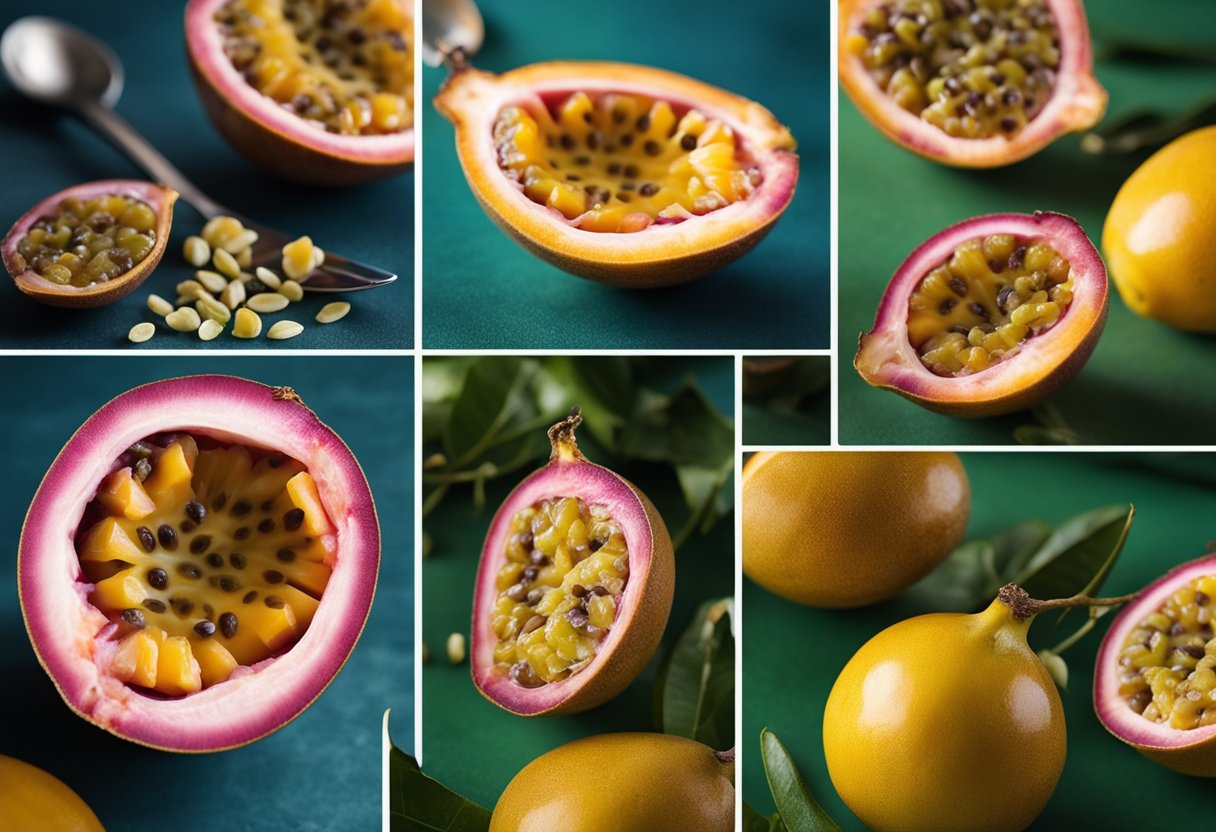
In the realm of baking, passion fruit can be used to create delicious cakes and other sweet treats. Its natural sweetness and tartness add depth and complexity to baked goods, providing a delightful contrast in flavors. When mixed into cake batters or used as a vibrant filling, passion fruit can elevate the overall taste and presentation of the dessert.
Passion fruit also makes an excellent addition to salads, as the seeds add an unexpected crunch and burst of flavor.
The fruit’s tangy taste can complement various ingredients, such as greens, nuts, and even other fruits. Indeed, the versatility of passion fruit is unmatched, as it can be used in all types of dishes, from sweet to savory.
No matter the dish, passion fruit has the ability to enhance and enrich any recipe it is included in. Whether it’s acting as a key component in sauces or gracing a beautifully plated dessert, passion fruit’s unique flavor profile makes it a beloved and sought-after ingredient in kitchens worldwide.
Preparing passion fruit dessert
Passion fruit is a versatile ingredient that can add a unique and exotic touch to a variety of desserts. It pairs well with creamy textures such as yogurt and ice cream, and can be used to create delightful curds and creams.
To prepare a passion fruit dessert, start by cutting the fruit in half and scooping out the seeds and pulp. The seeds can be strained to obtain the juice, which can be used to flavor various desserts like mousse or cake. If you prefer to incorporate the whole fruit, the seeds and pulp can be blended into smoothies or stirred into yogurt or ice cream.
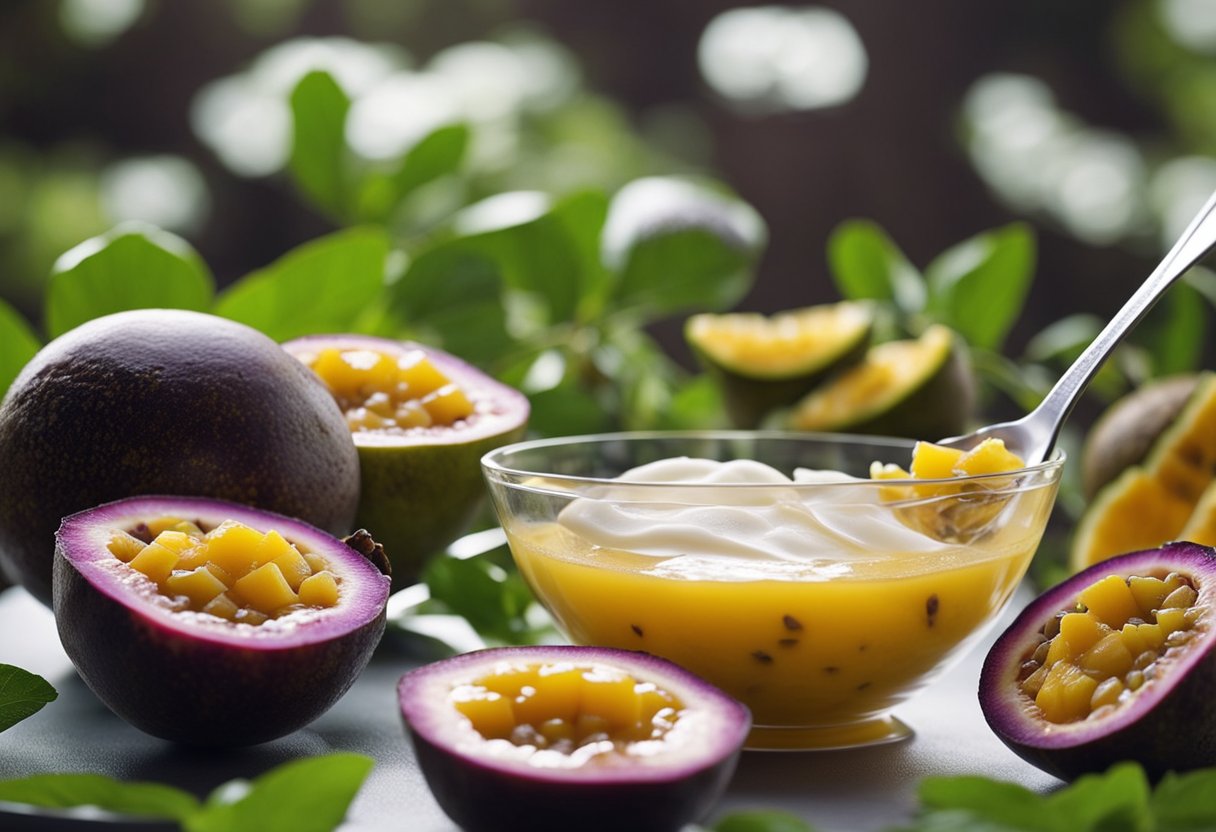
One popular dessert to make with passion fruit is a passion fruit curd. This rich and tangy filling can be used in pies, tarts, or simply spread on toast.
To make a curd, combine passion fruit juice, sugar, butter, and eggs in a saucepan and heat gently until the mixture thickens. The curd can be stored in a jar and refrigerated for future use.
Another delicious option is a passion fruit cream, which can be used to fill pastries or as a topping for other desserts. To make it, mix passion fruit juice with heavy cream and powdered sugar, and whip until soft peaks form. This light and airy cream adds an elegant touch to any dessert, and its fruity flavor complements other tropical and citrus ingredients.
If you’re looking for a frozen treat, try adding passion fruit to ice cream or sorbet. Creating a passion fruit swirl ice cream entails folding passion fruit puree into a vanilla ice cream base before freezing.
Alternatively, a refreshing passion fruit sorbet can be made by combining the fruit juice with sugar and water, and freezing the mixture in an ice cream maker.
In conclusion, passion fruit offers endless dessert possibilities. Whether used in baked goods, frozen treats, or creamy concoctions, its vibrant flavor and delightful texture are sure to impress.
Passion fruit health benefits
Passion fruit is a highly nutritious tropical fruit packed with essential vitamins, minerals, and dietary fiber. This fruit can positively impact various aspects of one’s health, from supporting the immune system to promoting healthy digestion.
One of the most significant health benefits of passion fruit is its high vitamin C content. Vitamin C is an essential nutrient that aids in immune function, collagen production, and the absorption of iron.
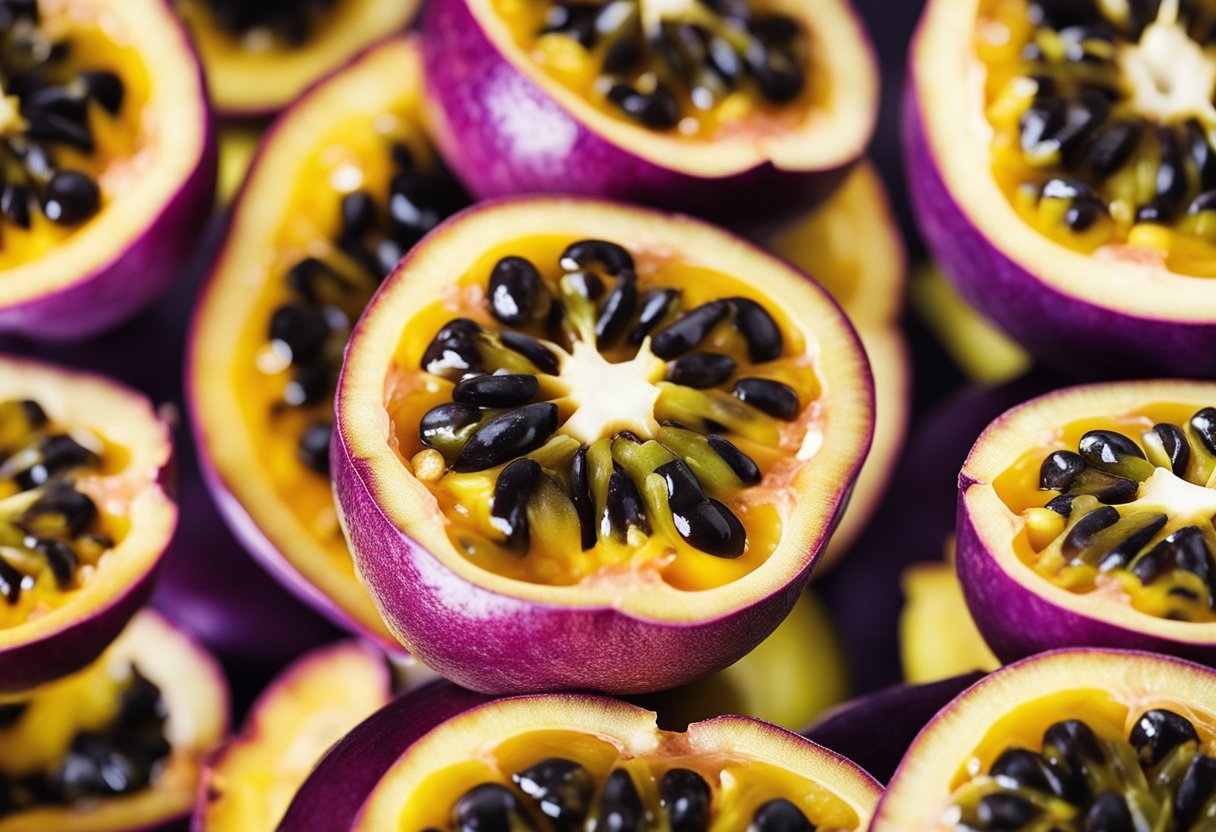
Consuming passion fruit regularly can help you meet your daily vitamin C requirements, protecting your immune system and maintaining overall well-being.
Additionally, passion fruit is an excellent source of vitamin A, which plays a vital role in promoting healthy skin, vision, and supporting the immune system. Vitamin A is a powerful antioxidant, and consuming foods rich in this nutrient can help protect your body from harmful free radicals, reducing the risk of chronic diseases.
The fruit is also rich in dietary fiber, an essential component for maintaining a healthy digestive system. Fiber is known to enhance gut health, reduce cholesterol levels, and lower the risk of heart disease and diabetes. Consuming passion fruit regularly can contribute to meeting your daily fiber needs and promote optimal gut health.
The presence of antioxidants in passion fruit is another key health benefit. Antioxidants help neutralize the harmful effects of free radicals, which can damage cells and contribute to chronic diseases like heart disease, diabetes, and cancer. Including passion fruit in your diet can provide an antioxidant boost, supporting your body’s natural defenses against oxidative stress.
Lastly, passion fruit contains essential minerals such as iron and potassium. Iron is necessary for the production of healthy red blood cells, while potassium helps maintain a healthy blood pressure and proper muscle and nerve function. By incorporating passion fruit into your diet, you can ensure a well-rounded intake of these vital minerals.
In conclusion, passion fruit offers an array of health benefits due to its rich content of vitamins, minerals, and antioxidants. Consuming this tropical fruit can support a strong immune system, healthy skin, optimal digestion, and reduce the risk of chronic diseases like heart disease and diabetes.
Passion fruit around the world
Passion fruit is a popular tropical fruit enjoyed by people worldwide. In Australia, it is often used in desserts and drinks, showcasing its sweet and tangy flavors. Australians also appreciate the versatility of the fruit, incorporating it into savory dishes like salads and sauces.
California and Hawaii have adopted the passion fruit – or lilikoi, as it’s known in Hawaii – and added it to their local cuisine. Locals enjoy passion fruit in beverages, jams, and various sweet treats. The fruit even gained popularity as an ingredient in craft beers and cocktails across California.
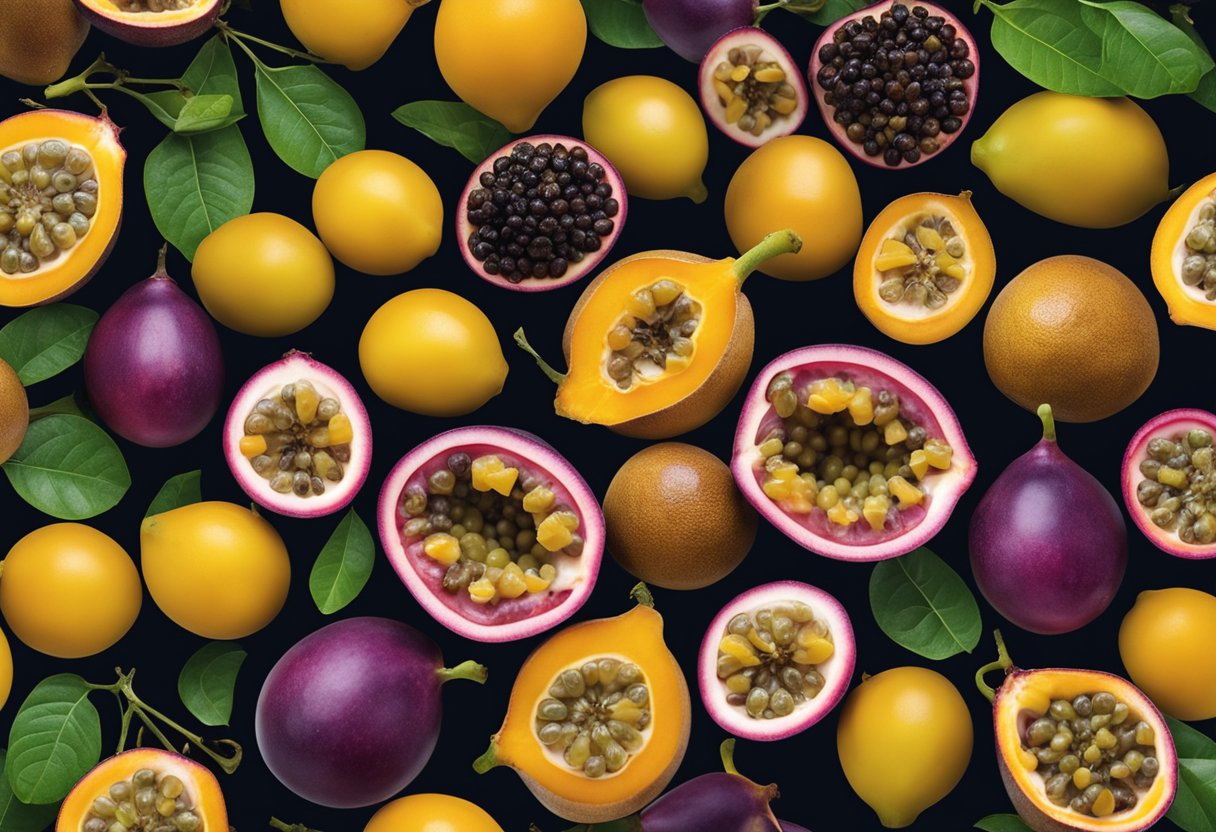
Florida has a favorable climate for passion fruit, and its residents appreciate the refreshing taste and pleasant aroma. It is commonly used to flavor tropical beverages and iconic local dishes like the popular key lime pie.
In Brazil, passion fruit is called maracujá and has become a staple in the country’s food culture. The fruit’s pulp is used in a wide array of recipes, including smoothies, cocktails, desserts, and savory sauces for meats and seafood.
The passion fruit comes in different varieties and colors. The green variety is slightly more tart and is commonly used in jams, whereas the yellow or purple types are sweeter and used in both sweet and savory preparations.
New Zealand is known for its passion for passion fruit; it plays a major role in the country’s culinary scene. Favored in desserts and beverages, the fruit brings a unique flavor to dishes and offers a taste of the tropics.
The fruit goes by different names depending on the location and variety. Maracuya is the term often used in Latin American countries, while granadilla refers to the rounder, orange variety of passion fruit. Both varieties have similar flavor profiles, with an exotic mix of sweet and tangy notes.
In conclusion, passion fruit has captured the imagination and taste buds of people globally. Its versatile use in various regions and dishes showcases its appeal and ultimately solidifies its place in the world’s culinary landscape.
Storage and choosing passion fruit
When selecting passion fruit, it is crucial to look for ones that feel heavy for their size and have slightly wrinkled skin. A heavier passion fruit indicates that it is full of juice, while the wrinkles on its surface are a sign of ripeness. If the skin appears smooth, the fruit may not be ripe yet, but you can still purchase it and allow it to ripen at room temperature.
Storing passion fruit properly helps to maintain its freshness and flavor. For ripe fruits, it is best to store them in the refrigerator to slow down the ripening process.
Place the passion fruit in a plastic bag or airtight container and store it in the refrigerator for up to two weeks. However, if the fruit is not yet ripe, it should be kept at room temperature, away from direct sunlight, until it ripens. Once ripened, transfer the fruit to the refrigerator for storage.
To enjoy the full flavor of passion fruit, you can consume it fresh or incorporate it into various recipes. If you have an abundance of ripe passion fruit and want to preserve it for a longer period, you can freeze the pulp.
To do this, scoop out the pulp of the fruit and place it in an airtight container or a freezer-safe plastic bag. Frozen pulp can be stored for several months and can be used later as a delicious ingredient in smoothies, desserts, and other dishes.
By following these guidelines, you can ensure that your passion fruit stays fresh, retains its flavor, and is ready to be enjoyed whenever you desire.
